Sizing Up Servers: Intel's Skylake-SP Xeon versus AMD's EPYC 7000 - The Server CPU Battle of the Decade?
by Johan De Gelas & Ian Cutress on July 11, 2017 12:15 PM EST- Posted in
- CPUs
- AMD
- Intel
- Xeon
- Enterprise
- Skylake
- Zen
- Naples
- Skylake-SP
- EPYC
Intel Expanding the Chipset: 10 Gigabit Ethernet and QuickAssist Technology
The refresh strategy from Intel on the chipset side has an ultra-long cadence. In recent memory, Intel’s platform launches are designed to support two generations of processor release, and in that time there is typically no chipset update, leaving the platform controller hub semi-static for functionality for usually three years. This is compared to the consumer side, where new chipsets are launched with every new CPU generation, with bigger jumps coming every couple of years. For the new launch today, Intel pushing the enterprise chipset ahead in a new direction.
The point of the chipset previously was to provide some basic IO support in the form of SATA/SAS ports, some USB ports, and a few PCIe lanes for simple controllers like USB 3.0, Gigabit Ethernet, or perhaps an x4 PCIe slot for a non-accelerator type card. The new chipsets, part of the C620 family codenamed Lewisburg, are designed to assist with networking, cryptography, and act more like a PCIe switch with up to 20 PCIe 3.0 lane support.
The headline features that matter most is the upgrade in DMI connection to the chipset, upgraded from DMI 2.0 to DMI 3.0 to match the consumer platforms, having those 20 PCIe 3.0 lanes from the chipset, and also the new feature under CPU Uplink.
For the new generation of Lewisburg chipsets, if an OEM requires that a platform has access to a cryptography engine or 10 Gigabit Ethernet, then they can attach 8 or 16 lanes from the processor into the chipset via this CPU Uplink port. Depending on which model of chipset is being used, this can provide up to four 10 GbE ports with iWARP RDMA, or up to 100 GB/s IPSec/SSL of QuickAssist support.
Intel will offer seven different versions of the chipset, varying in 10G and QAT support, but also varying in TDP:
On the cryptography side, Intel has previously sold add-in PCIe cards for QuickAssist, but is now moving it onto the systems directly. By adding it into the chipset, it can be paired with the Ethernet traffic and done in-situ, and specifically Intel points to bulk cryptography (150 Gb/s AES256/SHA256), Public Key Encryption (100k ops of RSA2048) and compression (100+ Gb/s deflate).
With the GbE, Intel has designed this to be paired with the X722 PHY, and supports network virtualization, traffic shaping, and supports Intel’s Data Plane Development Kit for advanced packet forwarding.
The chipset will also include a new feature called Intel’s Innovation Engine, giving a small embedded core into the PCH which mirrors Intel’s Management Engine but is designed for system-builders and integrators. This allows specialist firmware to manage some of the capabilities of the system on top of Intel’s ME, and is essentially an Intel Quark x86 core with 1.4MB SRAM.
The chipsets are also designed to be supported between different CPUs within the same multi-processor system, or for a system to support multiple chipsets at once as needed.


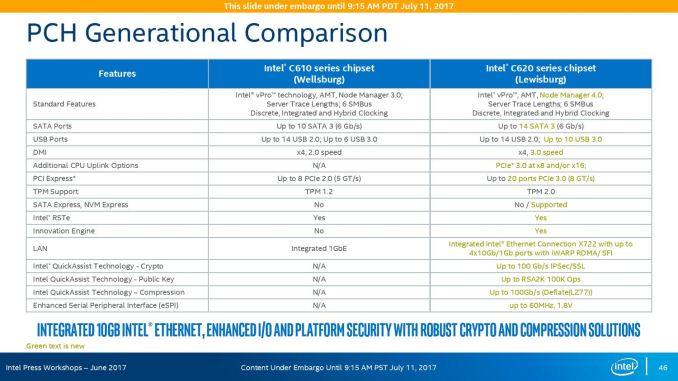
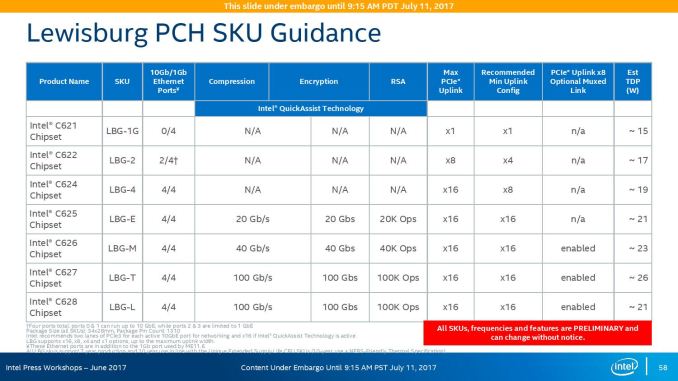
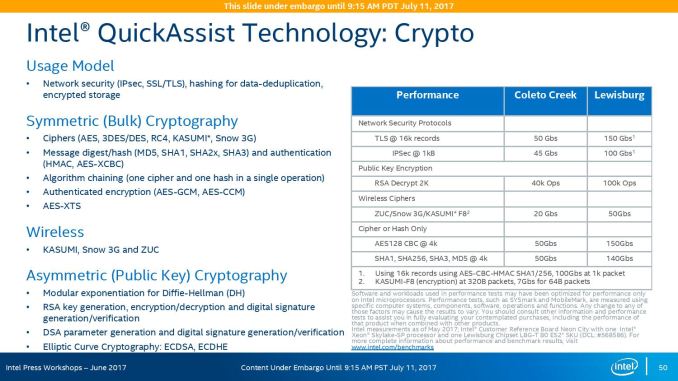

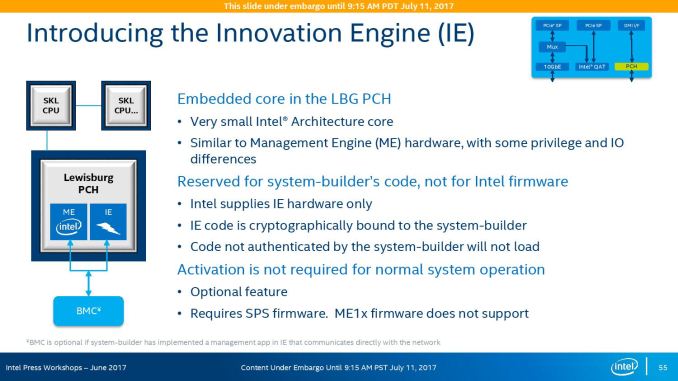
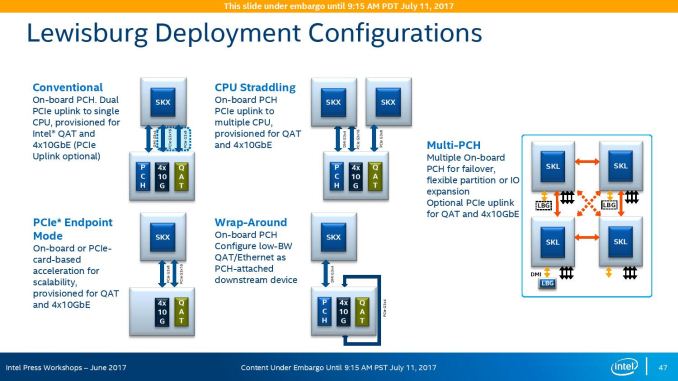








219 Comments
View All Comments
deltaFx2 - Thursday, July 13, 2017 - link
"Can you mention one innovation from AMD that changed the world?" : None. But the same applies to Intel too, save, I suppose, the founders (Moore and Noyce) contributions to IC design back when they were at Fairchild/Shockley. That's not Intel's contribution. Computer Architecture/HPC? That's IBM. They invented the field along with others like CDC. Intel is an innovator in process technology, specifically manufacturing. Or used to be... others are catching up. That 3-yr lead that INtel loves to talk about is all but gone. So with that out of the way...AMD's contributions to x86 technology: x86-64, hypertransport, integrated memory controller, multicore, just to name a few. Intel copied all of them after being absolutely hammered by Opteron. Nehalem system architecture was a copy-paste of Opteron. It is to AMD's discredit that they ceded so much ground on the CPU microarchitecture since then with badly executed Bulldozer, but it was AMD that brought high-performance features to x86 server. Intel would've just loved to keep x86 on client and Itanium on server (remember that innovative atrocity?). Then there's a bunch on the GPU side (which INtel can't get right for love or money), but that came from an acquisition, so I won't count those.
"AMD exists because they are always inferior". Remember K8? It absolutely hammered intel until 2007. Remember Intel's shenanigans bribing the likes of Dell to not carry K8? Getting fined in the EU for antitrust behaviors and settling with AMD in 2010? Not much of a memory card on you, is there?
AMD gaining even 5-10% means two things for intel: Lower margins on all but the top end (Platinum) and a loss in market share. That's plain bad for the stock.
"Intel is a data center giant have head start have the resources...". Yes, they are giants in datacenter compute. 99% market share. Only way to go from there is down. Also, those acquisitions you're talking about? Only altera applies to the datacenter. Also, remember McAfee for an eye-watering $7.8 bn? How's that working out for them?
Shankar1962 - Wednesday, July 12, 2017 - link
Nvidia who have been ahead than Intel in AI should be the more competent threatHow much market share Intel loses depends on how they compete against Nvidia
Amd will probably gain 5% by selling products for cheap prices
Intel controls 98/99% share so it's inevitable to lose a few % as more players see the money potential but unless Intel loses to Nvidia there is annuphill battle for Qualcomm ARM.
HanSolo71 - Wednesday, July 12, 2017 - link
Could you guys create a Benchmark for Virtual Desktop Solutions? These AMD chips sound awesome for something like my Horizon View environment where I have hundreds of 2 core 4GB machines.Threska - Saturday, July 22, 2017 - link
For VDI wouldn't either an APU setup, or CPU+GPU be better?msroadkill612 - Wednesday, July 12, 2017 - link
Kudos to the authors. I imagine its gratifying to have stirred such healthy & voluminous debate :)milkod2001 - Thursday, July 13, 2017 - link
Are you guys still updating BENCH results? I cannot find there benchmark results for RYZEN CPUs when i want to compare them to others.Ian Cutress - Friday, July 14, 2017 - link
They've been there since the launchAMD (Zen) Ryzen 7 1800X:
http://www.anandtech.com/bench/product/1853
KKolev - Thursday, July 13, 2017 - link
I wonder if AMD'd EPYC CPU's can be overclocked. If so, the AMD EPYC 7351P would be very interesting indeed.uklio - Thursday, July 13, 2017 - link
How could you not do Cinebench results?! we need an answer!JohanAnandtech - Thursday, July 13, 2017 - link
I only do server benchmarks, Ian does workstation. Ian helped with the introduction, he will later conduct the workstation benchmarks.